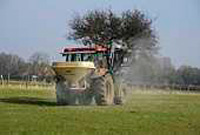Late mineralisation of N could still contribute, says ADAS

Possible late mineralisation of soil nitrogen reserves should be considered when interpreting soil mineral N test results this spring before making main top dressing recommendations.
Unusually low soil mineral N test results earlier this spring may in part be due to the very cold winter resulting in slower release of mineral N from soil organic matter, explains Peter Dampney of ADAS.
“If there has been a delay in mineralisation, then soil mineral N testing in January to March may have picked up less mineralised N than in a normal year.
“However, this soil N pool should still be released for crop uptake though later than normal. Our view is that for soil mineral N samples taken in early spring more allowance than usual should be made for N that will be mineralised in spring and summer.”
That may mean that the soil nitrogen supply level, which also takes account of mineralised N, is actually close to normal, he says.
“Unfortunately there is no research evidence to test this, but it should be considered when interpreting the results of soil mineral N tests this season.”
It has, however, been wetter this winter than average in most arable areas, meaning there will be less land in the ‘low’ excess rainfall (less than 150mm) that should use SNS Index table A in RB209, than in the moderate (150-250mm) and high (over 250mm) categories using tables B and C respectively, Mr Dampney says.
“Some growers may find they should be using a different SNS Index table than usual, which may result in a higher N recommendation. However, an increase of more than 20kg/ha of N on normal practice is unlikely to be justified.”
N recommendations
• Low soil mineral N tests
• Delayed mineralisation may still occur
• Winter rainfall higher
• Maximum 20kg/ha N increase

